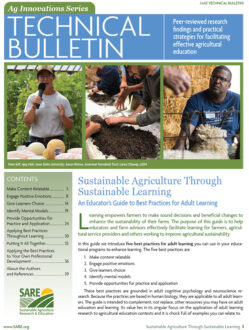Focus on Activities that Engage Positive Emotions
All people share the same set of core emotions. Positive emotions—joy and surprise—keep adult learners motivated and promote creative thinking, whereas negative emotions, such as fear and anger, can limit learning.
The Science Behind the Practice
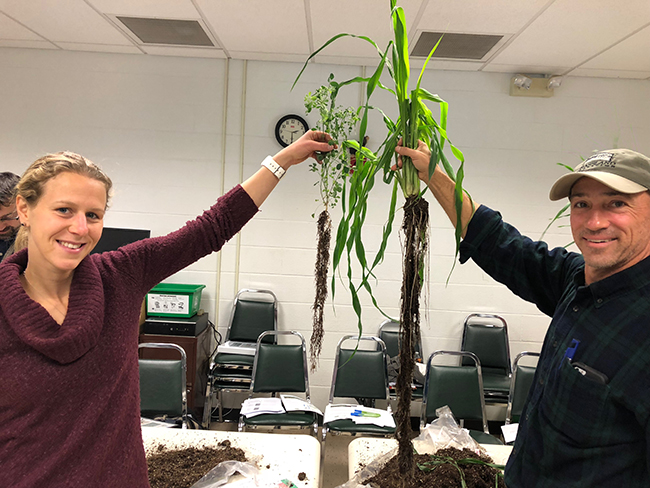
Humans experience a range of emotions, from sympathy and embarrassment to anticipation and contentment. Emotions serve many purposes. They enable individuals to make sense of their experiences and motivate them to make decisions or take action. The expression of emotions via body language, facial expressions and vocalizations plays an important role in communication among individuals. A small subset of emotions, known as core emotions, are especially important in learning.
Core emotions are shared by all humans, and they developed to enhance survival. Debate exists as to the exact number of core emotions, but researchers have found that five core emotions in particular have a strong impact on human learning: joy, surprise, anger, fear and disgust. We will focus on these emotions in this best practice.
Each core emotion has a unique set of automatic physiological and physical responses when triggered (Oh et al. 2020). For example, the heart races with fear or the head recoils with disgust. Distinctive conscious feelings also accompany each core emotion, such as feeling anxious with fear or nauseous with disgust. Each emotion has characteristic facial expressions that are recognized across cultures, so you can usually tell by a person’s facial expressions if they are experiencing surprise or disgust, for example. Depending on the perceived significance of the environmental trigger, core emotional responses can range from mild to strong.
Core emotional responses are initially controlled by the limbic system, found deep in the brain, which operates largely without your being conscious of it. Within a few seconds, however, outer layers of the brain in the cortex are activated and you become conscious of the experience. You are then able to “think” about the experience, react to the event in more complex and thoughtful ways, and remember it for the future. In this way, humans are able to learn from experiences that are associated with core emotions (Tyng et al. 2017). Because events and circumstances that trigger core emotions tend to be remembered for a long time, these emotions are thought to play an essential role in survival, helping to protect individuals from threats, adapt to circumstances and explore new opportunities.
Because events and circumstances that trigger core emotions tend to be remembered for a long time, these emotions are thought to play an essential role in survival, helping to protect individuals from threats, adapt to circumstances and explore new opportunities.
Core emotions are typically classified as either positive (joy and surprise) or negative (anger, fear and disgust). This distinction is important in education because the types of learning that are associated with positive emotions are quite different from the types of learning associated with negative emotions. In general, negative emotions tend to fix your attention on the things in the environment that triggered the emotion, limit your ability to think through the situation, and lead to impulsive actions (Alia-Klein et al. 2020). Positive emotions, on the other hand, tend to expand your attention, broaden your sense of what is possible under the circumstances, and motivate you to persist when challenged (Frederickson 2004).
Positive Core Emotions
When your goal is to help farmers learn new information and skills to creatively solve problems, then ensuring they experience positive core emotions when you teach is essential. The core emotion of joy is triggered when you perceive good fortune in your current circumstances. Surprise is triggered when you perceive something novel, yet safe, in your environment. Studies show that when adults have experiences that trigger joy and surprise they tend to do twice as well thinking of alternate ways to solve problems compared to when they are angry or fearful (Frederickson 2004). This is likely due to the role positive emotions play in helping learners remember the contextual or peripheral aspects of an experience and apply their intuitive knowledge to situations (Talarico et al. 2009).
Studies show that when adults have experiences that trigger joy and surprise they tend to do twice as well thinking of alternate ways to solve problems compared to when they are angry or fearful.
Joy. Joy is associated with expanding awareness and forming social bonds. Social activities enable adults to reap the benefits of social learning, such as being exposed to new perspectives and learning from others’ experiences. A great way to support joy among participants is to incorporate activities in which they collaborate on a task in small groups and then present their ideas to the whole group. Encourage peer feedback after presentations that is both supportive and constructive. Even introverted learners get enjoyment from group work when they are given alternative ways of contributing to the group (e.g., as note taker, timekeeper, etc.) and when the task requires successful collaboration among group members (Flanagan and Addy 2019).
The logistics of group activities and sharing will be different in face-to-face versus online educational programs; however, including opportunities for small group work brings positive emotional benefits in both settings. In online forums, designating an educator or peer facilitator in advance will help most learners engage more easily in group activities. The more learners engage in online group activities, the more comfortable and active they become.

Surprise. Surprise is associated with alertness, curiosity and motivation. In fact, the brain has a system, called the dopamine neuron system, that is dedicated to learning when you are surprised either by being exposed to something new or when you make an error.
An innovative way of triggering surprise has been used by pesticide safety educators to help farmers learn about safe handling of pesticides (Galvin et al. 2007). In this method, prior to instruction, each participant performs a mock pesticide application with a non-toxic solution containing a fluorescent tracer. A black light shows participants the extent to which they have contaminated their skin and clothing. Participants respond with surprise and alarm and become highly motivated to learn proper handling methods.
Educators should note that when adults are uncertain about what to expect from a learning event in terms of learning goals, teaching and evaluation methods or social interaction, they are less likely to feel positive emotions. If participants feel a lot of uncertainty in their interactions with you, then activities you hope will trigger pleasant surprise may instead cause anxiety.
To create an optimal environment to engage positive emotions—both joy and surprise—be sure to:
- Have clear learning goals
- Let participants know what types of peer interactions they will experience
- Provide clear instructions
- Be upfront about how learners will be evaluated
In the “How to Apply the Best Practice” section we describe a variety of activities designed specifically to support farmers in experiencing positive emotions during their learning.
Negative Core Emotions
Although the focus of this best practice is engaging positive emotions to promote learning, you may encounter situations in which farmers experience negative core emotions during learning events. In this section we cover some of the science about negative core emotions to give you an understanding of how these emotions can impact learning. We also describe ways you can mitigate the situation if farmers experience negative core emotions while you are teaching.
Studies show that when adults experience negative emotions, they make more mistakes in tests and are less successful in activities in which they need to apply their knowledge to solve novel problems.
As mentioned earlier, the human brain is designed to remember events that trigger strong core emotions. After an event in which a strong negative emotion was triggered you will likely remember every little detail for a long time. You may even run the event over and over in your head. What you learned from the experience will stay with you, but you may struggle to apply what you learned to new experiences. Studies show that when adults experience negative emotions, they make more mistakes in tests (Kuhbandner and Pekrun 2013) and are less successful in activities in which they need to apply their knowledge to solve novel problems (Brand et al. 2007). When negative core emotions like anger, fear and disgust are triggered frequently and for prolonged periods, the physiology of the body and brain change in ways that significantly impede any type of learning.
Anger. Anger is triggered when an individual attributes an adverse experience to someone or something. Anger motivates individuals into action. The action can be reactive and without focus, as in aggression, or it can be targeted and proactive. Educators, who are frequently called upon to provide advice to farmers, should note that when someone is experiencing anger, they are less likely to take advice from others (De Hooge et al. 2014). Farmers are more likely to consider your advice if you wait until their anger dissipates.
Sometimes the content covered in a learning event may be a trigger for anger. For example, a new environmental regulation may come up that some farmers perceive as a threat to their economic viability. There are two ways educators can help farmers channel the drive to “do something” that is associated with anger. First, support farmers in learning as much as they can about the trigger so that their actions can be effectual. Second, help farmers identify others who are affected by the issue. When experiencing anger, if individuals have a reason to act on behalf of others, their responses are more likely to be proactive than reactive. In the example of a contentious new regulation, connect farmers to trusted, credible sources about the environmental rationales behind the regulations and how the regulations will affect farm decisions. Facilitate meetings among farmers who will be affected or who may have already faced similar regulations to learn what others are doing and generate more positive responses to this change.
You can help diffuse farmers’ anger by making them feel supported and safe in their learning interactions with you, and by both allowing them to express their anger and acknowledging their viewpoints. Guide farmers in finding areas of common agreement regarding the circumstances surrounding the anger to set the stage for productive learning. For an example of how educators from Oregon State University have diffused anger around contentious topics, see the profile “Diffusing Anger When Addressing ‘Hot Topics.’”
Fear. Fear can be triggered by anything an individual perceives as a threat. In group learning settings like workshops, seminars, field days or webinars, fear may be triggered among individuals who perceive they do not “fit in” with the group, they are being singled out or that their perspectives and ideas are not being valued. A feeling of fear can cause an individual to retreat and disengage from activities.
In educational settings, depending on the social context, individuals who may be at risk for experiencing fear include members of minority racial or ethnic groups, recent immigrants, new or beginning farmers, and women farmers. As facilitator, a few ways you can mitigate the fear of not fitting in include:
- Ensuring each individual has the opportunity to introduce themselves, and if time allows, share something they hope to learn
- Setting “ground rules” for respectful interactions
- Encouraging participants to work with individuals they do not know during group activities
Disgust. Disgust is triggered when an individual perceives something as offensive, contaminated or diseased. It functions to preserve health and safety by enabling us to quickly avoid or reject something that is potentially harmful. Sometimes, educators may want learners to experience disgust as a way to help them learn about a particular precaution or safety skill. For example, in a session about health and safety, you can drive home the risk of skin cancer and the importance of sun protection by examining photos of skin lesions caused by sun exposure. If educators design the experience carefully so that it does not inadvertently trigger fear or anger, then disgust can positively impact learning by creating a very memorable experience. With this one exception, the vast majority of experiences facilitated by educators should involve positive emotions.
Wrap Up
The key to this best practice is ensuring that adult learners experience positive emotions during learning. The positive emotions of joy and surprise support learning in myriad ways. They are particularly beneficial in supporting collaborative learning and problem solving. Educators should avoid triggering fear or anger in learners, as these emotions limit learning.
How to Apply the Best Practice
Strategies for engaging positive emotions by reducing uncertainty and supporting social interactions.
- The more participants know in advance about what to expect from learning interactions, the more likely it is they will feel comfortable and situations that cause negative emotions can be minimized. For example:
- In program recruitment information, clearly state the program’s goals for learning, the program’s format, target participants (e.g., beginning or advanced level) and expectations for participation during the program.
- If advanced registration is required, send reminders and welcome messages to participants before the program with detailed directions, parking instructions and other logistics. Include the profile of participants, in general or in specific terms (with permission).
- In advance of an online program, send instructions for the technology that will be required during it, then conduct a technology check-in at the beginning to ensure everyone is well connected.
- When using technology, virtually or in person, have another colleague who can troubleshoot the audience’s technical challenges throughout the program.
- Invite participants to bring a learning partner. Social interaction is supported by having a trusted partner to discuss new ideas with.
- Be organized and prepared at events by having agendas, handouts, demonstrations, etc. ready ahead of time. Being well prepared allows you to focus on meeting and greeting participants at the beginning. A frazzled educator can create uncertainty and diminish learners’ comfort and confidence.
- At the beginning of a program, review the agenda, objectives and learning formats or activities you will use, ask for questions or concerns, and respond.
- Affirm “ground rules” for respectful discussion and openness to different viewpoints.
- Include time in your agenda for participants to introduce themselves, say where they are from, why they came and what they hope to take away. This is important in both in-person and online formats. Introductions can increase feelings of personal connection, help build a collegial atmosphere and provide an important first step towards building a learning community.
- Pay attention to nonverbal body language and facial expressions to remain aware of participants’ emotional states. If you notice indicators of fear or anger, pause instruction and invite participants to express any concerns, or invite participants to speak to you during a break.
- Include unstructured break time during longer events, and invite socializing and networking.
Strategies for triggering surprise and joy.
- Present relatable but startling, provocative or fun facts and figures related to content. Ask for reactions and spend a few minutes summarizing reactions before transitioning.
- Interject a surprising or humorous photograph, graphic or story that illustrates something relevant to the content.
- Every 10-15 minutes switch from presentation format to small-group or partner discussions, games or other activities. The interruptions can be short, such as mini breaks of just a minute or two for a quick question, poll or pause to reflect and jot down notes, or they can be longer breaks with time for teamwork and discussion. Try to include activities that invite movement and social interaction. Incorporating active intervals, even brief ones, will inject an element of surprise, which supports alertness and curiosity, and triggers joy, which supports social interaction and collaboration. Examples of activities include:
- Think-Pair-Share. Begin by posing a question related to the content to participants. Give time for everyone to think and write down their ideas. Pair individuals with a partner to share their ideas. If time allows, pairs share their ideas with the whole group.
- Brainstorm (verbal) or Brainwrite (written). Describe a problem, issue or challenge related to the content. Ask participants to work in pairs or small groups and brainstorm a variety of ways to address the problem. Encourage participants to be creative and not to be concerned with logistics or resources that would be needed to enact an idea. Allot time to share ideas with the whole group.
- What Do You See? Show a picture or video related to your topic and ask a discussion question, such as “What do you see in this picture/video?” or “What is wrong with this picture/video?”
- Object Pass Around. Pass around objects or specimens related to the topic and invite participants to examine them. Then, invite discussion. (This might be an opportunity for triggering some memorable disgust.)
- Agree? Disagree? Why? Hand out cards containing statements related to the content or show a slide with a statement. Statements may be provocative or value laden, or may address common myths or misperceptions about the content. Have participants read cards and then discuss whether they agree or disagree with the statement, and why.
- Poll. Incorporate a quick poll and discuss results. A variety of formats can support polls, such as electronic clickers, colored or numbered cards that participants can hold up, cell phone poll apps, placing dots on a poster or flip chart, or moving to different locations in the room to vote.
- Quick Quiz. Ask brief quiz questions (written or verbal) or tests of knowledge and experience about a topic before and/or after addressing it. If at a field event, conduct a quick quiz before or after a field or tour stop.
Review Questions and Reflections
- Think of a memorable “positive” past learning experience. What two or three things do you remember about it? Did anything relate to the emotions of joy or surprise? If yes, how? Were any other emotions involved?
- In what ways do the positive emotions of joy and surprise promote learning?
- If you are working with an adult learner who is feeling very angry or fearful, how might their learning be impaired? How might you manage these negative emotions if they manifest during learning?
- Think of a future learning program you are planning. What three things could you do to ensure that you focus on positive emotions during it? In your answer, be specific about how you can include joy and surprise to promote learning.
Profiles
Diffusing Anger When Addressing “Hot Topics”
Mary Halbleib, Oregon State University Extension
Climate change and pesticide environmental risk assessment are two topics that Mary Halbleib has seen provoke anger among some farmers in Oregon. Halbleib has heard provocative reactions such as, “You’re not here to tell me the climate is changing, are you?” and “Let’s abolish the EPA” in the opening moments of meetings focused on collaboratively exploring new ways to reduce environmental impacts from agriculture. Promptly addressing such reactions is necessary to avoid an early derailment of the meeting’s atmosphere and purpose.
Halbleib offers an effective strategy for diffusing anger and moving the program into productive learning. Calmly and gently, provide an alternative perspective about what the farmers have been experiencing in recent years regarding the weather, or about how the EPA’s role in pesticide approval is key to having a range of products on the market. Following a brief discussion, the group generally agrees that the weather is more erratic now, or that yes, the EPA does play a vital role for agriculture, and participants can then move on to constructively achieve the intended outcome for the meeting. By approaching the topics in this way, words and concepts that some consider provocative and politically charged are less likely to trigger anger.
Educators may find this non-confrontational technique of diffusing anger and redirecting participants towards a productive discussion useful in many contexts.
Engaging Positive Emotions in a Tractor Safety Workshop for Women Farmers
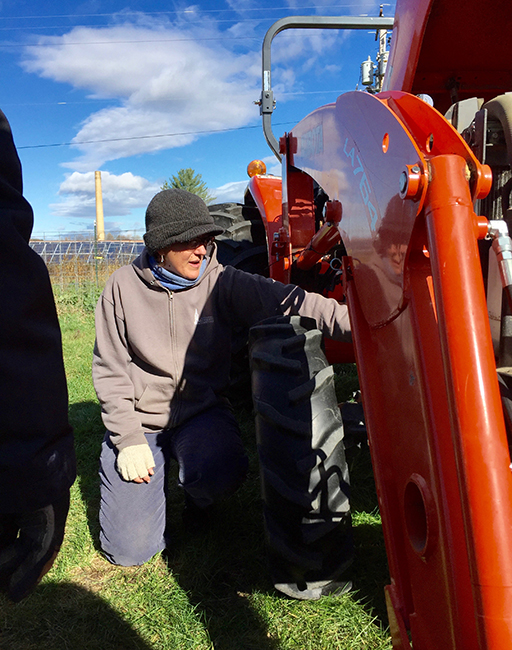
Beth Holtzman, University of Vermont Extension
Farm mechanization can be challenging and sometimes intimidating for some women farmers, especially those who have little prior experience operating and maintaining machinery. Recognizing the need to engage positive emotions for women to learn these skills, a team led by Beth Holtzman offered a series of tractor safety and operation workshops in Vermont specifically designed for women beginning farmers (https://blog.uvm.edu/groundwk/). In addition to covering key concepts in tractor safety and operation, the small-cohort workshop format provided all participants with hands-on opportunities to drive, hitch a wagon/trailer and attach/detach power take-offs (PTOs). The educators’ observations of participants during the workshop and participants’ evaluation comments showed that this format provided a positive and psychologically safe environment that supported the women learning these traditionally male-dominated skills.
“Instead of standing back and silently watching me give instructions to one student at a time, all the students just naturally offered each other advice and suggestions,” an instructor observed. “They didn’t take over for each other but did point out things the current hands-on student might want to try, or just gave her encouragement. I think this gave a more positive and collaborative feeling to the whole afternoon, with the bonus that I, too, felt like I understood hitching a lot better by the end of the day!”
One of the participants said, “I think the fact it was all women participating in the course was empowering and a connecting experience. It was less stressful and frustrating, and I enjoyed it that much more.”
For more information
SARE project: Breaking barriers: Building capacity to provide tractor education (2013)
Read more: https://projects.sare.org/project-reports/ene13-127/
Creating a More Inclusive Environment for Hispanic Learners
Elsa Sanchez, Penn State Extension
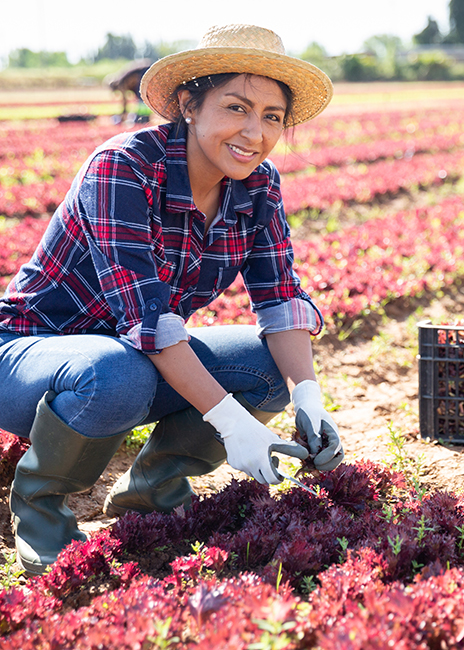
With the number of Hispanic farmers growing steadily in Pennsylvania in recent years, Elsa Sanchez led a project in 2015 to help educators better understand and address barriers to participation in Extension programs among Hispanic farmers and farmworkers. Potential barriers they identified included lack of awareness of Extension or other agricultural programming, a misperception that programming was focused on other farmers and not them, settings that felt uncomfortable or fearful, and timing that conflicted with other obligations. While most Hispanics in the United States are U.S. citizens and are proficient in both English and Spanish, some experience a lack of programming in Spanish and fear of government or authority as barriers. Also recognized as a barrier was that many Extension educators were unfamiliar with thinking of Hispanics as farmers rather than as farmworkers.
The educators identified and committed to a variety of strategies to make their programs more inclusive for Hispanic farmers and farmworkers, such as:
- Including pictures of diverse speakers and participants in advertisements
- Advertising in Spanish and in English, and through businesses connected to the Hispanic community
- Developing a registration system that does not require internet access, an email account or credit card information, as some potential participants may not have internet access or may be reluctant to share this information
- Providing childcare or an activity for children attending events with their caregivers
- Using translators or hosting bilingual events
- If an educator is not a Spanish speaker, encouraging them to learn some key phrases in Spanish, even if it is rudimentary, to connect with Hispanic farmers and farmworkers who prefer to communicate in Spanish
- Using presentations rich in graphics rather than text
- Seeking out farmers and building trust and personal relationships. Such activities can involve taking time to find and meet individuals at their farms, community gatherings or cultural events; arriving early and staying late at events to talk; and discussing information other than program topics to develop a personal connection.
For more information
SARE project: Creating a sense of belonging for Hispanic farmers in Extension programming (2015)
Read more: https://projects.sare.org/sare_project/ene15-139/
Chicken Surprise!
Richard Brzozowski, University of Maine Cooperative Extension
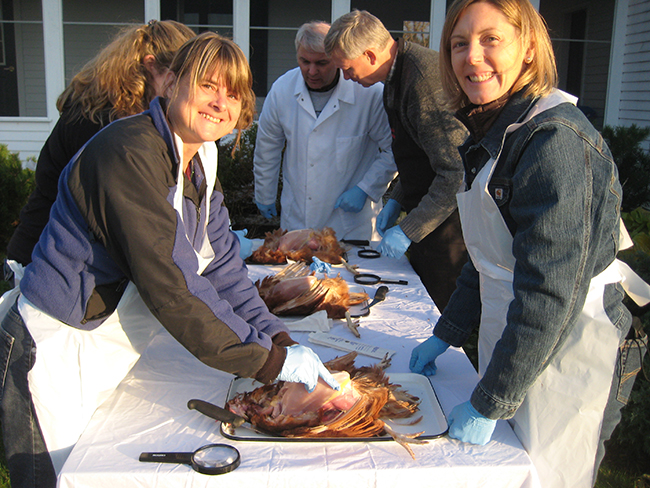
The element of surprise can be used to great effect when introducing a core component of your educational program. Richard Brzozowski did just that when he brought the element of surprise into workshops about small-scale poultry production. During a workshop discussion about assessing the health status and potential pests of poultry, Brzozowski produced crates with live birds for participants to physically examine and assess. For those new to poultry production, this was certainly a novel experience that focused attention well, inspired curiosity to learn and provided a hands-on opportunity to develop important skills. Participants worked with partners to inspect the birds, discuss what they observed and relate their observations to what they had learned about poultry pests and health status indicators. Later, working together, participants learned how to slaughter and process the chickens. The workshop culminated with the group preparing and sharing a chicken dinner, where the positive emotions evoked by the day of collaborative learning were evident in the smiles.
For more information
SARE project: Professional development for agricultural service providers in applied poultry science (2010)
Read more: https://projects.sare.org/project-reports/ene10-116/
